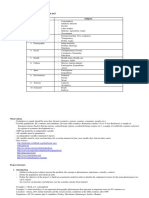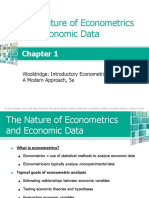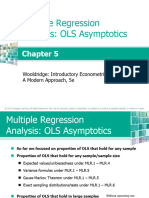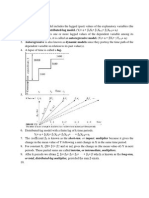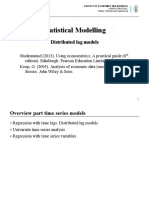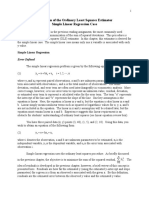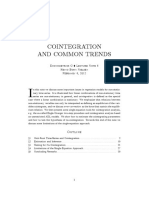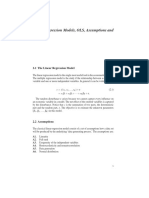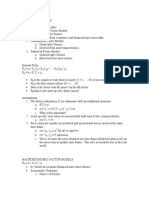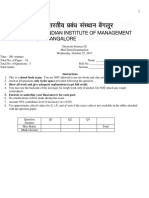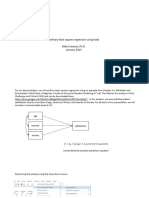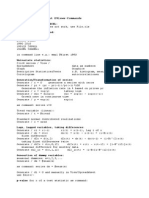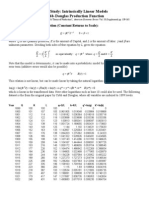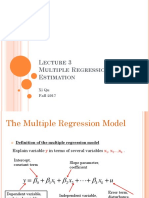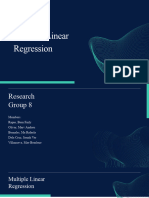Introductory Econometrics: A Modern Approach (7e)
Chapter 10
Basic Regression Analysis with Time
Series Data
© 2020 Cengage. May not be scanned, copied or duplicated, or posted to a publicly accessible website, in whole or in part, except for use as permitted in a license distributed with a certain product or service or otherwise on a
password-protected website or school-approved learning management system for classroom use. 1
� Introductory Econometrics: A Modern Approach (7e)
Basic Regression Analysis with Time Series Data (1 of 25)
• The nature of time series data
• Temporal ordering of observations; may not be arbitrarily reordered
• Typical features: serial correlation/nonindependence of observations
• How should we think about the randomness in time series data?
• The outcome of economic variables (e.g. GNP, Dow Jones) is uncertain; they
should therefore be modeled as random variables.
• Time series are sequences of r.v. (= stochastic processes)
• Randomness does not come from sampling from a population.
• “Sample” = the one realized path of the time series out of the many possible
paths the stochastic process could have taken.
© 2020 Cengage. May not be scanned, copied or duplicated, or posted to a publicly accessible website, in whole or in part, except for use as permitted in a license distributed with a certain product or service or otherwise on a
password-protected website or school-approved learning management system for classroom use. 2
� Introductory Econometrics: A Modern Approach (7e)
Basic Regression Analysis with Time Series Data (2 of 25)
• Example: US inflation and unemployment rates 1948-2003
Year Inflation Unemployment
1948 8.1 3.8
• Here, there are only two time
1949 -1.2 5.9 series. There may be many more
1950
1951
1.3
7.9
5.3
3.3
variables whose paths over time
are observed simultaneously.
…
…
1998 1.6 4.5
1999
2000
2.2
3.4
4.2
4.0
• Time series analysis focuses on
2001 2.8 4.7 modeling the dependency of a
2002
2003
1.6
2.3
5.8
6.0
variable on its own past, and on
the present and past values of
other variables.
© 2020 Cengage. May not be scanned, copied or duplicated, or posted to a publicly accessible website, in whole or in part, except for use as permitted in a license distributed with a certain product or service or otherwise on a
password-protected website or school-approved learning management system for classroom use. 3
� Introductory Econometrics: A Modern Approach (7e)
Basic Regression Analysis with Time Series Data (3 of 25)
• Examples of time series regression models
• Static models
• In static time series models, the current value of one variable is modeled as the
result of the current values of explanatory variables
• Examples for static models
© 2020 Cengage. May not be scanned, copied or duplicated, or posted to a publicly accessible website, in whole or in part, except for use as permitted in a license distributed with a certain product or service or otherwise on a
password-protected website or school-approved learning management system for classroom use. 4
� Introductory Econometrics: A Modern Approach (7e)
Basic Regression Analysis with Time Series Data (4 of 25)
• Finite distributed lag models
• In finite distributed lag models, the explanatory variables are allowed to
influence the dependent variable with a time lag.
• Example for a finite distributed lag model
• The fertility rate may depend on the tax value of a child, but for biological and
behavioral reasons, the effect may have a lag.
© 2020 Cengage. May not be scanned, copied or duplicated, or posted to a publicly accessible website, in whole or in part, except for use as permitted in a license distributed with a certain product or service or otherwise on a
password-protected website or school-approved learning management system for classroom use. 5
� Introductory Econometrics: A Modern Approach (7e)
Basic Regression Analysis with Time Series Data (5 of 25)
• Interpretation of the effects in finite distributed lag models
• Effect of a past shock on the current value of the dep. variable
© 2020 Cengage. May not be scanned, copied or duplicated, or posted to a publicly accessible website, in whole or in part, except for use as permitted in a license distributed with a certain product or service or otherwise on a
password-protected website or school-approved learning management system for classroom use. 6
� Introductory Econometrics: A Modern Approach (7e)
Basic Regression Analysis with Time Series Data (6 of 25)
• Graphical illustration of lagged effects
• The effect is biggest after a lag
of one period. After that, the
effect vanishes (if the initial
shock was transitory).
• The long run effect of a
permanent shock is the
cumulated effect of all relevant
lagged effects. It does not
vanish (if the initial shock is a
permanent one).
© 2020 Cengage. May not be scanned, copied or duplicated, or posted to a publicly accessible website, in whole or in part, except for use as permitted in a license distributed with a certain product or service or otherwise on a
password-protected website or school-approved learning management system for classroom use. 7
� Introductory Econometrics: A Modern Approach (7e)
Basic Regression Analysis with Time Series Data (7 of 25)
• Finite sample properties of OLS under classical assumptions
• Assumption TS.1 (Linear in parameters)
• Assumption TS.2 (No perfect collinearity)
“In the sample (and therefore in the underlying time series process), no
independent variable is constant nor a perfect linear combination of the others.”
© 2020 Cengage. May not be scanned, copied or duplicated, or posted to a publicly accessible website, in whole or in part, except for use as permitted in a license distributed with a certain product or service or otherwise on a
password-protected website or school-approved learning management system for classroom use. 8
� Introductory Econometrics: A Modern Approach (7e)
Basic Regression Analysis with Time Series Data (8 of 25)
• Notation
• Assumption TS.3 (Zero conditional mean)
© 2020 Cengage. May not be scanned, copied or duplicated, or posted to a publicly accessible website, in whole or in part, except for use as permitted in a license distributed with a certain product or service or otherwise on a
password-protected website or school-approved learning management system for classroom use. 9
� Introductory Econometrics: A Modern Approach (7e)
Basic Regression Analysis with Time Series Data (9 of 25)
• Discussion of assumption TS.3
• Strict exogeneity is stronger than contemporaneous exogeneity
• TS.3 rules out feedback from the dependent variable on future values of the
explanatory variables; this is often questionable especially if explanatory
variables “adjust” to past changes in the dependent variable.
• If the error term is related to past values of the explanatory variables, one
should include these values as contemporaneous regressors.
© 2020 Cengage. May not be scanned, copied or duplicated, or posted to a publicly accessible website, in whole or in part, except for use as permitted in a license distributed with a certain product or service or otherwise on a
password-protected website or school-approved learning management system for classroom use. 10
� Introductory Econometrics: A Modern Approach (7e)
Basic Regression Analysis with Time Series Data (10 of 25)
• Theorem 10.1 (Unbiasedness of OLS)
• Assumption TS.4 (Homoskedasticity)
• A sufficient condition is that the volatility of the error is independent of the
explanatory variables and that it is constant over time.
• In the time series context, homoskedasticity may also be easily violated, e.g. if
the volatility of the dep. variable depends on regime changes.
© 2020 Cengage. May not be scanned, copied or duplicated, or posted to a publicly accessible website, in whole or in part, except for use as permitted in a license distributed with a certain product or service or otherwise on a
password-protected website or school-approved learning management system for classroom use. 11
� Introductory Econometrics: A Modern Approach (7e)
Basic Regression Analysis with Time Series Data (11 of 25)
• Assumption TS.5 (No serial correlation)
• Discussion of assumption TS.5
• Why was such an assumption not made in the cross-sectional case?
• The assumption may easily be violated if, conditional on knowing the values of
the indep. variables, omitted factors are correlated over time.
• The assumption may also serve as substitute for the random sampling
assumption if sampling a cross-section is not done completely randomly.
• In this case, given the values of the explanatory variables, errors have to be
uncorrelated across cross-sectional units (e.g. states).
© 2020 Cengage. May not be scanned, copied or duplicated, or posted to a publicly accessible website, in whole or in part, except for use as permitted in a license distributed with a certain product or service or otherwise on a
password-protected website or school-approved learning management system for classroom use. 12
� Introductory Econometrics: A Modern Approach (7e)
Basic Regression Analysis with Time Series Data (12 of 25)
• Theorem 10.2 (OLS sampling variances)
Under assumptions TS.1 – TS.5:
• Theorem 10.3 (Unbiased estimation of the error variance)
© 2020 Cengage. May not be scanned, copied or duplicated, or posted to a publicly accessible website, in whole or in part, except for use as permitted in a license distributed with a certain product or service or otherwise on a
password-protected website or school-approved learning management system for classroom use. 13
� Introductory Econometrics: A Modern Approach (7e)
Basic Regression Analysis with Time Series Data (13 of 25)
• Theorem 10.4 (Gauss-Markov Theorem)
• Under assumptions TS.1 – TS.5, the OLS estimators have the minimal variance
of all linear unbiased estimators of the regression coefficients.
• This holds conditional as well as unconditional on the regressors.
• Assumption TS.6 (Normality)
• Theorem 10.5 (Normal sampling distributions)
• Under assumptions TS.1 – TS.6, the OLS estimators have the usual normal
distribution (conditional on X). The usual F and t-tests are valid.
© 2020 Cengage. May not be scanned, copied or duplicated, or posted to a publicly accessible website, in whole or in part, except for use as permitted in a license distributed with a certain product or service or otherwise on a
password-protected website or school-approved learning management system for classroom use. 14
� Introductory Econometrics: A Modern Approach (7e)
Basic Regression Analysis with Time Series Data (14 of 25)
• Example: Static Phillips curve
• Discussion of CLM assumptions
• TS.1: The error term contains factors such as monetary shocks, income/demand
shocks, oil price shocks, supply shocks, or exchange rate shocks.
• TS.2: A linear relationship might be restrictive, but it should be a good
approximation. Perfect collinearity is not a problem as long as unemployment
varies over time.
© 2020 Cengage. May not be scanned, copied or duplicated, or posted to a publicly accessible website, in whole or in part, except for use as permitted in a license distributed with a certain product or service or otherwise on a
password-protected website or school-approved learning management system for classroom use. 15
� Introductory Econometrics: A Modern Approach (7e)
Basic Regression Analysis with Time Series Data (15 of 25)
• Discussion of CLM assumptions (cont.)
© 2020 Cengage. May not be scanned, copied or duplicated, or posted to a publicly accessible website, in whole or in part, except for use as permitted in a license distributed with a certain product or service or otherwise on a
password-protected website or school-approved learning management system for classroom use. 16
� Introductory Econometrics: A Modern Approach (7e)
Basic Regression Analysis with Time Series Data (16 of 25)
• Example: Effects of inflation and deficits on interest rates
• Discussion of CLM assumptions
• TS.1: The error term represents other factors that determine interest rates in
general, e.g. business cycle effects.
• TS.2: A linear relationship might be restrictive, but it should be a good
approximation. Perfect collinearity will seldomly be a problem in practice.
© 2020 Cengage. May not be scanned, copied or duplicated, or posted to a publicly accessible website, in whole or in part, except for use as permitted in a license distributed with a certain product or service or otherwise on a
password-protected website or school-approved learning management system for classroom use. 17
� Introductory Econometrics: A Modern Approach (7e)
Basic Regression Analysis with Time Series Data (17 of 25)
• Discussion of CLM assumptions (cont.)
© 2020 Cengage. May not be scanned, copied or duplicated, or posted to a publicly accessible website, in whole or in part, except for use as permitted in a license distributed with a certain product or service or otherwise on a
password-protected website or school-approved learning management system for classroom use. 18
� Introductory Econometrics: A Modern Approach (7e)
Basic Regression Analysis with Time Series Data (18 of 25)
• Using dummy explanatory variables in time series
• Interpretation
• During World War II, the fertility rate was temporarily lower.
• It has been permanently lower since the introduction of the pill in 1963.
© 2020 Cengage. May not be scanned, copied or duplicated, or posted to a publicly accessible website, in whole or in part, except for use as permitted in a license distributed with a certain product or service or otherwise on a
password-protected website or school-approved learning management system for classroom use. 19
� Introductory Econometrics: A Modern Approach (7e)
Basic Regression Analysis with Time Series Data (19 of 25)
• Time series with trends
• Example for a time series with a linear upward trend:
© 2020 Cengage. May not be scanned, copied or duplicated, or posted to a publicly accessible website, in whole or in part, except for use as permitted in a license distributed with a certain product or service or otherwise on a
password-protected website or school-approved learning management system for classroom use. 20
� Introductory Econometrics: A Modern Approach (7e)
Basic Regression Analysis with Time Series Data (20 of 25)
• Modelling a linear time trend
• Modelling an exponential time trend
© 2020 Cengage. May not be scanned, copied or duplicated, or posted to a publicly accessible website, in whole or in part, except for use as permitted in a license distributed with a certain product or service or otherwise on a
password-protected website or school-approved learning management system for classroom use. 21
� Introductory Econometrics: A Modern Approach (7e)
Basic Regression Analysis with Time Series Data (21 of 25)
• Example for a time series with an exponential trend
• Abstracting from random deviations, the time series has a constant growth rate
© 2020 Cengage. May not be scanned, copied or duplicated, or posted to a publicly accessible website, in whole or in part, except for use as permitted in a license distributed with a certain product or service or otherwise on a
password-protected website or school-approved learning management system for classroom use. 22
� Introductory Econometrics: A Modern Approach (7e)
Basic Regression Analysis with Time Series Data (22 of 25)
• Using trending variables in regression analysis
• If trending variables are regressed on each other, a spurious relationship may
arise if the variables are driven by a common trend.
• In this case, it is important to include a trend in the regression.
• Example: Housing investment and prices
© 2020 Cengage. May not be scanned, copied or duplicated, or posted to a publicly accessible website, in whole or in part, except for use as permitted in a license distributed with a certain product or service or otherwise on a
password-protected website or school-approved learning management system for classroom use. 23
� Introductory Econometrics: A Modern Approach (7e)
Basic Regression Analysis with Time Series Data (23 of 25)
• Example: Housing investment and prices (cont.)
• When should a trend be included?
• If the dependent variable displays an obvious trending behaviour
• If both the dependent and some independent variables have trends
• If only some of the independent variables have trends; their effect on the
dependent variable may only be visible after a trend has been substracted
© 2020 Cengage. May not be scanned, copied or duplicated, or posted to a publicly accessible website, in whole or in part, except for use as permitted in a license distributed with a certain product or service or otherwise on a
password-protected website or school-approved learning management system for classroom use. 24
� Introductory Econometrics: A Modern Approach (7e)
Basic Regression Analysis with Time Series Data (24 of 25)
• A detrending interpretation of regressions with a time trend
• It turns out that the OLS coefficients in a regression including a trend are the
same as the coefficients in a regression without a trend but where all the
variables have been detrended before the regression.
• This follows from the general interpretation of multiple regressions.
• Computing R-squared when the dependent variable is trending
• Due to the trend, the variance of the dependent variable will be overstated.
• It is better to first detrend the dependent variable and then run the regression
on all the independent variables (plus a trend if they are trending as well).
• The R-squared of this regression is a more adequate measure of fit.
© 2020 Cengage. May not be scanned, copied or duplicated, or posted to a publicly accessible website, in whole or in part, except for use as permitted in a license distributed with a certain product or service or otherwise on a
password-protected website or school-approved learning management system for classroom use. 25
� Introductory Econometrics: A Modern Approach (7e)
Basic Regression Analysis with Time Series Data (25 of 25)
• Modelling seasonality in time series
• A simple method is to include a set of seasonal dummies:
• Similar remarks apply as in the case of deterministic time trends
• The regression coefficients on the explanatory variables can be seen as the
result of first deseasonalizing the dep. and the explanatory variables.
• An R-squared that is based on first deseasonalizing the dependent variable may
better reflect the explanatory power of the explanatory variables.
© 2020 Cengage. May not be scanned, copied or duplicated, or posted to a publicly accessible website, in whole or in part, except for use as permitted in a license distributed with a certain product or service or otherwise on a
password-protected website or school-approved learning management system for classroom use. 26







